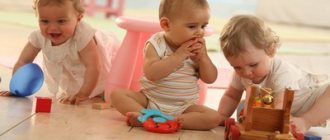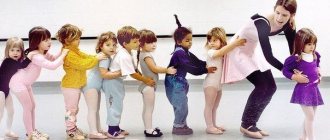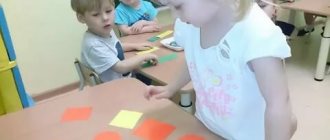Daily routine and its importance for preschoolers
3. The organization of the daily routine is carried out taking into account the warm and cold periods of the year
WHAT IS THE DAY SCHEDULE IN KINDERGARTEN?
The importance of a child's daily routine
A correct regimen that corresponds to the child’s age-related capabilities improves health, ensures efficiency, successful implementation of various activities, and protects against overwork. In a child accustomed to a strict routine, the need for food, sleep, and rest occurs at certain intervals and is accompanied by rhythmic changes in the activity of all internal organs. The body, as it were, adjusts in advance to the upcoming activity, so it is carried out quite efficiently, without unnecessary waste of nervous energy and does not cause pronounced fatigue. Good performance during the day is ensured by a variety of activities and their alternation. From a physiological point of view, this is explained by the ability of the cerebral cortex to simultaneously work and rest. At each individual moment, not its entire surface is working, but individual areas, namely those that are in charge of this activity (the field of optimal excitability). The remaining areas of the cortex are at rest at this time. All physiological processes in the body, having their own biological rhythm, obey a single daily rhythm - the change of day and night. During the day, the child’s activity and performance are not the same. Their rise is noted from 8 to 12 hours and from 16 to 18 hours, and the period of minimum performance occurs at 14-16 hours. It is no coincidence, therefore, that activities that cause pronounced fatigue in children are planned in the first half of the day, during hours of optimal performance. The duration of periods of wakefulness in preschoolers is limited to 5-6 hours. This implies the need to alternate wakefulness and sleep.
HYGIENIC ASPECTS OF ORGANIZING THE DAY REGIME FOR PRESCHOOL CHILDREN
The concept of “daily routine” includes the duration, organization and distribution during the day of all types of activities, rest and meals. A rationally constructed and organized regime is an important factor in ensuring timely and harmonious physical and mental development of children and adolescents, an optimal level of performance, and also prevents the development of fatigue and increases the overall resistance of the body.
In connection with the beginning of early education and its intensification, deviations are noted in the daily routine of preschoolers, forming functional and other health disorders.
The main hygienic principle of constructing a rational daily routine is its strict implementation, the inadmissibility of frequent changes, and the gradual transition to a new regime of education and training.
Conditions and features of the organization of the regime in early age groups. article
Conditions and features of the organization of the regime in early age groups.
For the normal development of a child and strengthening his health, it is important:
- implementation of the regime throughout the entire period of raising children in a preschool institution, starting from an early age;
- maintaining constancy, consistency and gradualness in the conduct of regime processes. Consistency must be maintained not only in terms of daily routine, but also in terms of consistent demands from all group personnel.
The main task of group staff when organizing special moments is to take care of the health and physical well-being of the child. This is facilitated by:
- timeliness of food intake;
- timely and sufficient duration of daytime sleep;
— compliance of children’s clothing with the microclimate in the group and the season outside.
Principles for the effective distribution of responsibilities between group personnel:
- The teacher works in the area where the pedagogical requirements are more complex and responsible. The teacher must do the bulk of the work in the initial period of developing independence skills.
- The teacher's assistant serves children who have already partially mastered the skill.
Basic principles of organizing the regime in early age groups:
- Ensure the unity of health and educational work.
- Ensure unity and consistency of approach on the part of ALL educators, namely:
- kindergarten,
- family,
— continuity in the work of all group personnel.
3. Ensure frequent and predominantly individual communication between the child and adults, especially during the adaptation period;
4. Ensure friendly communication between the adult and the child, creating a favorable emotional environment in the group. Communication should be predominantly smooth, calm, affectionate and emotional. You should not be afraid of kind words addressed to children. But we must remember that they must go from a pure heart. Avoid stock words and phrases!
5. Ensure correct adult behavior. Remember the golden rule: the behavior of an adult is a role model for a child. The child is a mirror; in play he copies the actions of adults, especially the negative aspects (this is how parents find out what is happening in the kindergarten).
6. Ensure that children in the group are in an active, cheerful state.
When organizing the regime, you must follow certain rules:
1. Each of the regime moments must take place against the background of the game.
2. When carrying out regime processes, first a subgroup of the smallest and most weakened, slow and, on the contrary, easily excitable children is taken;
3. Provide for uniformity of requirements on the part of adults raising a child in a child care institution and at home.
4. Create a certain mood in children to carry out a particular process (do not injure the nervous system).
5. The implementation of any regime process should proceed without fuss. Adults should accompany their actions with gentle, unhurried speech.
6. Build the child’s confidence that everything will work out, he will be able to complete this or that action to the end. Notice something new that the child has already learned.
7. It is necessary to remember the hygienic requirements: for premises (compliance with the schedule of wet cleaning, ventilation); to the size of furniture in accordance with height; to the appearance of children and adults; to the feeding process, etc.
8. Use such a method of relationship between an adult and a child as mother therapy.
9. Individual communication and approach to children must be observed. The teacher must be able to pay attention to all children, at the same time ensure frequent communication with each individual, and master specific methods of group education
10. To successfully develop cultural and hygienic skills, their systematic reinforcement is necessary.
Specifics of the organization of regime processes.
Organization of a walk.
Staying in the fresh air improves health and strengthens the body, comprehensively develops children, activates their motor activity and cognitive abilities.
Gathering children for a walk (as well as returning) is the most labor-intensive and time-consuming process. Every day, about 15% of staff time is spent on dressing children. Therefore, the rationality of organizing this process is very important. The most convenient method is considered to be the so-called frontal method of dressing children, when they simultaneously put on leggings, shoes, sweaters, and lastly coats (jackets) and hats. At the same time, we should not forget about maintaining consistency and gradualism, as well as an individual approach to children.
Organization of the feeding process.
The feeding process is not only a process of satisfying hunger. During meals, an adult should impart knowledge to children and expand their understanding and vocabulary. Tell them the names of the dishes, their quality and condition: sweet, tasty, hot, salty, etc.
During feeding, the tables at which children sit should be divided between the teacher and the assistant teacher to monitor and provide the necessary assistance. Children who sit down first at the table should finish eating earlier. Otherwise, the rule according to which younger and weaker children are put to bed first is violated. Adults must be able to properly feed children. Under no circumstances should you hang over your child! You need to take a high chair, sit next to the child, and feed him with a clean spoon (another one).
Do not forget to pay attention to moral education based on imitation. From early childhood, it is necessary to cultivate correct behavior while eating: eat silently, do not disturb others, be careful, etc.
It is necessary to develop a positive attitude towards the process of eating and towards food. Children should not be force-fed.
Organization of direct educational activities.
Classes in early age groups are held 2 times a day (morning and evening), lasting 10 minutes in subgroups. The assistant teacher plays a big role here, because the rest of the children are under her supervision.
The teacher must use various techniques to maintain an optimal state of excitability, protecting children from fatigue, which can arise when children are constantly in a group if mistakes are made in the process of organizing education.
Organization of physiological cleansing and washing.
It is necessary to monitor the regularity of physiological procedures, but remember that no more than 3-4 children should be in the toilet room at the same time and no more than 3-4 minutes. Mass planting is carried out before the start of direct educational activities, a walk, after its completion, before going to bed and after getting up.
When organizing the washing process with children, a teacher and an assistant teacher must be present, because Two skills must be developed at once: washing your hands and face correctly and drying your hands correctly with a towel.
One day in kindergarten, rough plan
Most preschool institutions work twelve hours (from 7.00 to 19.00). The daily routine in the kindergarten is drawn up accordingly: starting at seven in the morning, children are received, ending with them going home at seven in the evening.
- Morning. In the morning, the teacher receives children, conducts exercises and organized educational activities (classes) with them. Children also have breakfast in the morning, and in their free time they can play or chat with other children.
- Reception of children. The day begins with the teacher receiving the children from their parents. Here it is important to create a positive emotional mood among the guys in the entire group. When a teacher receives a child, he is interested in his state of health and can also answer some questions from parents.
- Morning work-out. In order to give children a boost of energy for the whole day, exercises are included in the kindergarten schedule in the morning, which involves a number of specific physical exercises. Daily exercises help strengthen the musculoskeletal system of children, making them more resilient and healthy. Exercises can be carried out either by the teacher himself or by a physical education worker. Usually, morning exercises are performed with musical accompaniment in the gym for physical education classes (except for nursery and junior groups).
- Breakfast. The daily routine in preschool educational institutions strictly regulates the time children eat, in particular, breakfast.
- Classes (educational activities). The teacher conducts classes in a playful way so that the children better understand the material. The duration of classes varies in different groups, taking into account the age of the children. On average they last from 10 to 25 minutes.
The daily routine of the kindergarten includes the following types of activities:
- cognitive development,
- mathematical development,
- speech development,
- familiarization with fiction,
- productive activities (modeling, design, appliqué),
- creative activity,
- music,
- Physical Culture.
- Day. The daily schedule of the kindergarten includes a walk, lunch and nap.
- The kindergarten routine certainly includes a daytime walk for children. It promotes children's health, hardening, development of movements and their general cognitive development. Usually, walks in kindergarten are carried out in any weather. The reasons for its cancellation are strong gusts of wind, heavy rain, heavy snowfall and blizzards, severe frost, etc. During drizzling rain and light snowfall, children walk on the verandas, which are specially provided for this purpose. In different age groups, the walk lasts its own specific time.
- After the walk, the children have lunch. In order to restore energy after cognitive and active activity, the child is offered to eat a full lunch, which consists of salad, first, second and third courses.
- Preschool children simply need daytime sleep, so it must be included in the daily routine in kindergarten. The duration of sleep depends on the age of the children. Typically, daytime sleep lasts from one and a half to three hours.
- Evening. Evening is considered to be the time after bedtime and before the children go home. During these hours, children have more time for independent play activities, and the teacher can carve out a few minutes for individual work with this or that child.
- After the children wake up, they go to lunch. This is a light snack that will help your child not feel hungry until dinner.
- For older children (senior and preparatory groups), an additional walk is included in the kindergarten schedule after afternoon tea.
- Educational activities are also provided in the evening. Classes are held in groups of younger and middle age. It could be modeling or drawing, music or physical education. In the evening, children are given more time for independent activities, role-playing or board games.
- Around five o'clock in the evening, the children sit down to dinner, and after that they begin to be taken home.







